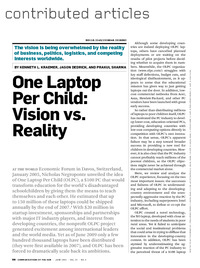One Laptop per ChildVision vs. Reality
Kenneth L. Kraemer, Jason Dedrick, Prakul Sharma
|
 |
 Diese Seite wurde seit 5 Jahren inhaltlich nicht mehr aktualisiert.
Unter Umständen ist sie nicht mehr aktuell.
Diese Seite wurde seit 5 Jahren inhaltlich nicht mehr aktualisiert.
Unter Umständen ist sie nicht mehr aktuell.
 Zusammenfassungen
Zusammenfassungen
 At the World Economic Forum in Davos, Switzerland,
January 2005, Nicholas Negroponte unveiled the idea
of One Laptop Per Child (OLPC), a $100 PC that would
transform education for the world’s disadvantaged
schoolchildren by giving them the means to teach
themselves and each other. He estimated that up
to 150 million of these laptops could be shipped
annually by the end of 2007.
4
With $20 million in
startup investment, sponsorships and partnerships
with major IT industry players, and interest from
developing countries, the nonproft OLPC project
generated excitement among international leaders
and the world media. Yet as of June 2009 only a few
hundred thousand laptops have been distributed
(they were frst available in 2007), and OLPC has been
forced to dramatically scale back its ambitions.
At the World Economic Forum in Davos, Switzerland,
January 2005, Nicholas Negroponte unveiled the idea
of One Laptop Per Child (OLPC), a $100 PC that would
transform education for the world’s disadvantaged
schoolchildren by giving them the means to teach
themselves and each other. He estimated that up
to 150 million of these laptops could be shipped
annually by the end of 2007.
4
With $20 million in
startup investment, sponsorships and partnerships
with major IT industry players, and interest from
developing countries, the nonproft OLPC project
generated excitement among international leaders
and the world media. Yet as of June 2009 only a few
hundred thousand laptops have been distributed
(they were frst available in 2007), and OLPC has been
forced to dramatically scale back its ambitions. Dieser wissenschaftliche Zeitschriftenartikel erwähnt ...
Dieser wissenschaftliche Zeitschriftenartikel erwähnt ...
 Begriffe KB IB clear |  OLPC OLPC One Laptop per Child Project One Laptop per Child Project
|
 Anderswo finden
Anderswo finden
 Volltext dieses Dokuments
Volltext dieses Dokuments
 One Laptop per Child: Artikel als Volltext (HTML) ( One Laptop per Child: Artikel als Volltext (HTML) (  : :  2021-03-21) 2021-03-21) | |
 |  One Laptop per Child: Artikel als Volltext (PDF) ( One Laptop per Child: Artikel als Volltext (PDF) ( : :  , 1685 kByte; , 1685 kByte;  : :  2020-11-28) 2020-11-28) |
 Anderswo suchen
Anderswo suchen 
 Beat und dieser wissenschaftliche Zeitschriftenartikel
Beat und dieser wissenschaftliche Zeitschriftenartikel
Beat hat Dieser wissenschaftliche Zeitschriftenartikel während seiner Zeit am Institut für Medien und Schule (IMS) ins Biblionetz aufgenommen. Beat besitzt kein physisches, aber ein digitales Exemplar. Eine digitale Version ist auf dem Internet verfügbar (s.o.). Aufgrund der wenigen Einträge im Biblionetz scheint er es nicht wirklich gelesen zu haben. Es gibt bisher auch nur wenige Objekte im Biblionetz, die dieses Werk zitieren.












 Biblionetz-History
Biblionetz-History